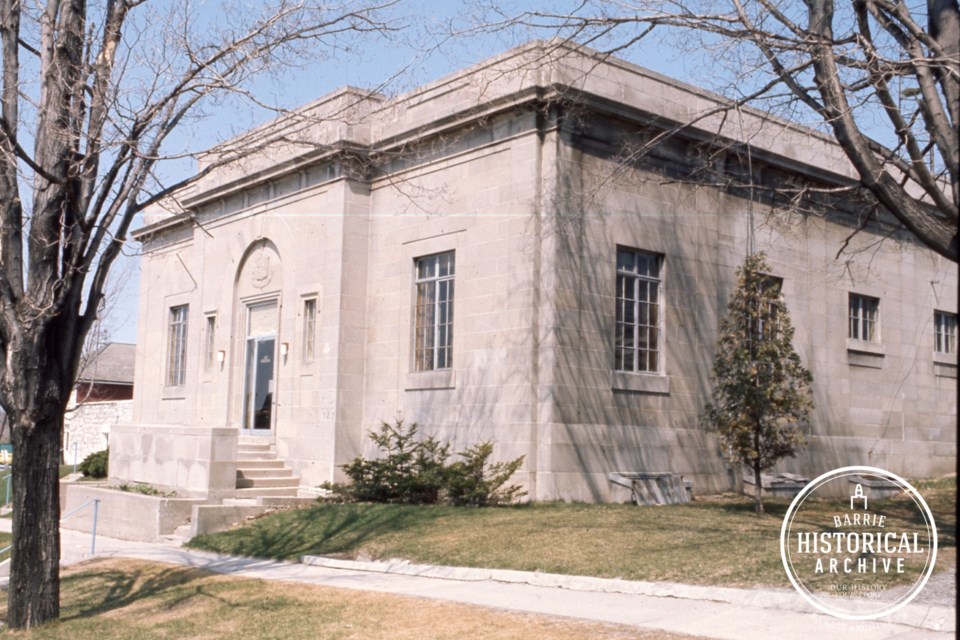This ongoing series from Barrie Historical Archive curator Deb Exel shows old photos from the collection and one from the present day, as well as the story behind them.
The Women’s Institute
In October, Women’s History Month, it would be a glaring oversight to not talk about one of the most important contributions to history: the Women’s Institute.
Addie Hunter, the youngest of 12, was born on the family farmstead in St. George, Ont., in 1857. Her father died a few months after her birth, leaving her mother to manage the farm and the family.
Addie’s early education was in a one-room school house until she moved to Brantford to live with her sister while she attended Ladies College. It was then that Addie met her husband, Hamilton furniture manufacturer John Hoodless. No longer a farm girl, but a socialite, Adelaide, as she was now called, lived a privileged Victorian life with John and their four children.
Tragedy struck in 1889, when she lost her 14-month-old son to what was referred to at the time as the summer complaint — an intestinal affliction caused by drinking impure milk. As a diligent and educated parent, Adelaide was stunned at her lack of the most basic understanding of domestic science. Realizing there must be scores of women like her, unaware of this health hazard within their homes, Adelaide began her mission to share knowledge and support women in rural communities, becoming an advocate for education, family health, and community service.
Hearing one of her talks, Erland Lee invited Adelaide to speak at his Farmers Institute Ladies Night. After speaking that evening in 1897, at the home of Janet and Erland Lee in Saltfleet (Stoney Creek), Adelaide proposed forming a group to meet about domestic education and food safety. When she returned in a week’s time, 101 women had gathered, thus establishing the first branch of the Women’s Institute. The importance of the work of women — “homecraft and mothercraft,” the care of the home and all the loved ones within it — was the powerful foundation for what would become the Women’s Institute, the largest international women’s organization ever.
Other important happenings occurred in that same year. Adelaide was invited by the minister of education to write a textbook focusing on hygiene and cleanliness for domestic sciences courses. The governor general’s wife, Lady Aberdeen, troubled by rural families with limited or no access to medical care, consulted Adelaide — who, at the time, was involved in the National Council for Women — on establishing a Canadian branch of the Victorian Order of Nurses. Domestic sciences would become part of Ontario school curriculum about 1902, but Adelaide already had a vision for domestic sciences at the university level and had convinced non-smoking tobacco baron William McDonald, of Montreal, to fund a program in both Ontario and Quebec.
Adelaide Hoodless died of a cerebral hemorrhage in 1910 while speaking on the topic of women and industrial life to a group at St. Margaret’s College in Toronto. Both her family farm in St. George and Erland Lee’s home in Stoney Creek are historical sites.
Women’s Institutes formed across Ontario. Even the smallest villages and hamlets had a branch. Beyond education, advocating for women’s and children’s rights, improving lives and serving their communities, the Women’s Institutes did something else. Their value and importance can never be overstated.
In 1925, the Committee for Historical Research and Current Events was established for the purpose of studying local history to get a better understanding of the lives of our ancestors. The Women’s Institutes were believed to be the best positioned to document local history. The first settlers, histories of farms, the local economy, buildings such as schools, community centres and churches, the families, war veterans and other details of their community life would be written by the local Women’s Institutes. From simple scrapbooks to beautifully bound volumes, these women’s groups gathered photographs, newspaper clippings, family records, and logs of meetings and events to chronicle the history of their communities.
Lady Tweedsmuir, wife of the 15th governor general of Canada, a keen advocate for the preservation of history, strongly urged the Women’s Institutes to maintain detailed local history records. She was thrilled when, in 1940, these local books were named for her late husband: the Tweedsmuir Village History Books. Creating a historical archive of their communities was seen as the perfect project for the 50th anniversary of the Women’s Institute movement, and every branch in Ontario was encouraged to participate. The local records were named Tweedsmuir History Books at the 1947 anniversary celebration.
The Barrie Women’s Institute was established Oct. 6, 1916. The Simcoe County Women’s Institute (formed in 1925) Museum opened in the former Land Registrar’s Office on Oct. 11, 1934. The Registry Office on Worsley Street had been erected in 1875 to replace the 1846 original just to the west of it. It was built to be fireproof and featured a stone foundation and floors, slate roof, walls of arcaded white brick with 19-foot ceilings, and iron shutters. It was demolished to make room for the new courthouse, and the artifacts were relocated.
Now referred to as Tweedsmuir Community History Books, these materials continue to be compiled to this day. Thanks to the preservation efforts of the Women’s Institutes, historians, researchers and lovers of local history can learn about their families, heritage and communities from these wonderful regional archives.



